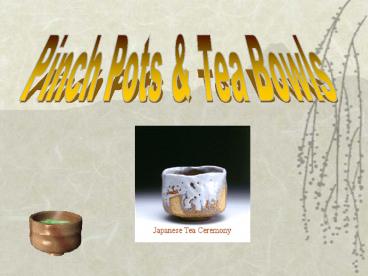Pinch Pots - PowerPoint PPT Presentation
1 / 26
Title:
Pinch Pots
Description:
The beauty of things imperfect, impermanent, incomplete. Tea Ceremony. Chanoyu ... Imperfect, impermanent, and incomplete. Modest and humble. Unconventional ... – PowerPoint PPT presentation
Number of Views:1578
Avg rating:3.0/5.0
Title: Pinch Pots
1
Pinch Pots Tea Bowls
2
Clay VocabularyPinch
- Pinch
- Forming a pot by pinching with the fingers and
the thumb
3
Clay VocabularyTypes of clay
- Stoneware
- High fire clay. Fires at 2400
- Earthenware
- Low fire clay. Fires at 1800
4
Clay VocabularyBody of a Pot
- Lip / Rim
- The top edge of a pot
- Foot
- The bottom of a pot
lip
5
Clay Vocabulary
- Slip
- Clay Water Clay glue
- Liquid Clay
- Score Slip
- Roughing up the clay and adding slip
- For attaching clay together
6
Clay Vocabulary
- Texture
- The look and feel of an object
7
Clay VocabularyStages of Drying
- Leather Hard
- 1st stage of drying
- Clay is cold, stiff, and leathery
- Greenware
- Completely dry pottery (bone dry)
Greenware
8
Clay VocabularyFiring
- Kiln
- An oven which fires clay
- Bisque ware
- Fired, unglazed pottery
- Glaze
- Glass-former, applied to pottery
- Glaze ware
9
Tea Bowl VocabularyJapan
- Wabi Sabi
- The beauty of things imperfect, impermanent,
incomplete - Tea Ceremony
- Chanoyu
- Ritualized way of serving tea
A wood-carving made by Japanese artist Toshikata
Mizuno (1866-1903)depicting a tea ceremony
10
Japanese Tea Cermony
Chanoyu
11
Aesthetics
- Aesthetics
- Value and beauty as they relate to the arts
- Japanese Aesthetics
- Affected by the Chinese and Buddhism
- Value of harmony in all things
- Nature-based, concerned with the beauty of
simplicity and harmony with nature - Wabi-Sabi
- Beauty of simplicity and harmony
12
Wabi-Sabi
- Wabi-Sabi
- Beauty of things
- Imperfect, impermanent, and incomplete
- Modest and humble
- Unconventional
- Characteristics of wabi-sabi
- Suggestion of natural process, irregular,
intimate, unpretentious, earthy, simple - Correlates with concepts of Zen Buddhism
13
Japanese Tea CeremonyChanoyu
- Chanoyu
- Serving of tea, ritualized over time
- Symbolizes simplicity and represent the Zen
principles of - harmony, respect, purity, and tranquility.
14
Tea Facts
- Tea was first used in Asia (13th c.)
- Its green before it is processed
- Called Matcha
- Tea began as a medicine grew into a drink
- Buddhist monks used it to stay awake during hours
of meditation - Europeans discovered tea from Asia. 16th c.
15
The Tea Ceremony
- Ceremony is usually a gathering of 4 guests
- A break from daily stress
- The guests pass through a small garden
- Enter a quite shaded place while waiting to be
called on by the host - Host will sound a gong. The garden path is
called Roji
Path of stepping stones in Korakuen garden in
Okayama
16
Roji - a dewy path The roji is a way apart from
this bustling world and its many cares.
How will the path sweep away the dust
from within out hearts? Namboroku, a poem
ascribed to a tea master Sen no Rikyu (1522-1591)
17
Entering the Tearoom
- To enter the tearoom, guests must
- Remove their shoes
- Clean their hands and mouth with water
- Pass through a small opening (3 ft. high)
18
Inside the Tearoom
- The tearoom is
- Kept empty
- Empty space is beautiful and valued
- Inside there is an alter to house scroll painting
and a flower arrangement
19
(No Transcript)
20
The Tea bowl
- Often Raku bowls with a foot are used
- Irregular in shape and texture (wabiSabi)
- Handbuilt
- Have own personal character
- Designed to fit the hand well
21
The Tea CeremonyChanoyu
- The tea ceremony is an art form
- Prepared by a tea master
- Takes 20 years to become a tea master
- Every move before, during, and after the ceremony
has rules - The ceremony teaches
- Harmony with the universe,
- and tranquility
22
Shapes and Feet of Tea Bowls
23
Tea bowls
24
(No Transcript)
25
(No Transcript)
26
Credits
- Created by Jerilynn Packer
- Sources
- Tea Ceremony in Japan www.coolskool.net/japan/tea_
ceremony.htm - Tea Bowl Imperfect Harmony Article from
Greater Lafayette Museum - Japanese Aesthetics, Wabi-Sabi, and the Tea
Ceremony - Holy Mountain trading Co. The tea ceremony.
www.holymtn.com

